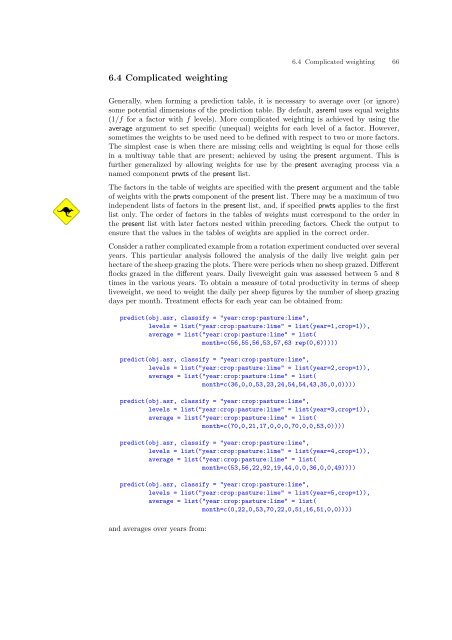ASReml-S reference manual - VSN International
ASReml-S reference manual - VSN International
ASReml-S reference manual - VSN International
- No tags were found...
You also want an ePaper? Increase the reach of your titles
YUMPU automatically turns print PDFs into web optimized ePapers that Google loves.
6.4 Complicated weighting 666.4 Complicated weightingGenerally, when forming a prediction table, it is necessary to average over (or ignore)some potential dimensions of the prediction table. By default, asreml uses equal weights(1/f for a factor with f levels). More complicated weighting is achieved by using theaverage argument to set specific (unequal) weights for each level of a factor. However,sometimes the weights to be used need to be defined with respect to two or more factors.The simplest case is when there are missing cells and weighting is equal for those cellsin a multiway table that are present; achieved by using the present argument. This isfurther generalized by allowing weights for use by the present averaging process via anamed component prwts of the present list.The factors in the table of weights are specified with the present argument and the tableof weights with the prwts component of the present list. There may be a maximum of twoindependent lists of factors in the present list, and, if specified prwts applies to the firstlist only. The order of factors in the tables of weights must correspond to the order inthe present list with later factors nested within preceding factors. Check the output toensure that the values in the tables of weights are applied in the correct order.Consider a rather complicated example from a rotation experiment conducted over severalyears. This particular analysis followed the analysis of the daily live weight gain perhectare of the sheep grazing the plots. There were periods when no sheep grazed. Differentflocks grazed in the different years. Daily liveweight gain was assessed between 5 and 8times in the various years. To obtain a measure of total productivity in terms of sheepliveweight, we need to weight the daily per sheep figures by the number of sheep grazingdays per month. Treatment effects for each year can be obtained from:predict(obj.asr, classify = "year:crop:pasture:lime",levels = list("year:crop:pasture:lime" = list(year=1,crop=1)),average = list("year:crop:pasture:lime" = list(month=c(56,55,56,53,57,63 rep(0,6)))))predict(obj.asr, classify = "year:crop:pasture:lime",levels = list("year:crop:pasture:lime" = list(year=2,crop=1)),average = list("year:crop:pasture:lime" = list(month=c(36,0,0,53,23,24,54,54,43,35,0,0))))predict(obj.asr, classify = "year:crop:pasture:lime",levels = list("year:crop:pasture:lime" = list(year=3,crop=1)),average = list("year:crop:pasture:lime" = list(month=c(70,0,21,17,0,0,0,70,0,0,53,0))))predict(obj.asr, classify = "year:crop:pasture:lime",levels = list("year:crop:pasture:lime" = list(year=4,crop=1)),average = list("year:crop:pasture:lime" = list(month=c(53,56,22,92,19,44,0,0,36,0,0,49))))predict(obj.asr, classify = "year:crop:pasture:lime",levels = list("year:crop:pasture:lime" = list(year=5,crop=1)),average = list("year:crop:pasture:lime" = list(month=c(0,22,0,53,70,22,0,51,16,51,0,0))))and averages over years from:
















